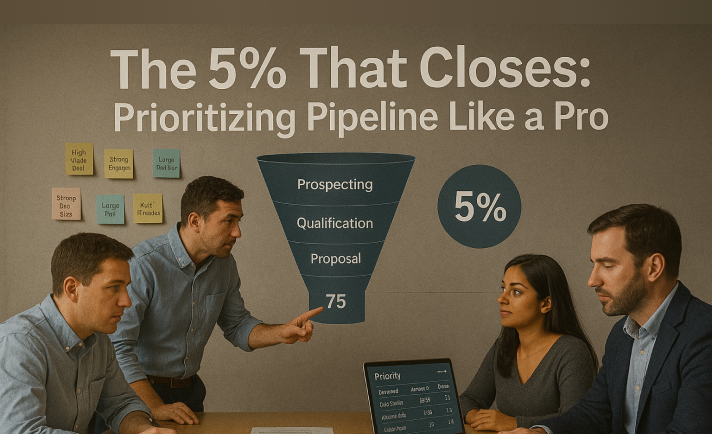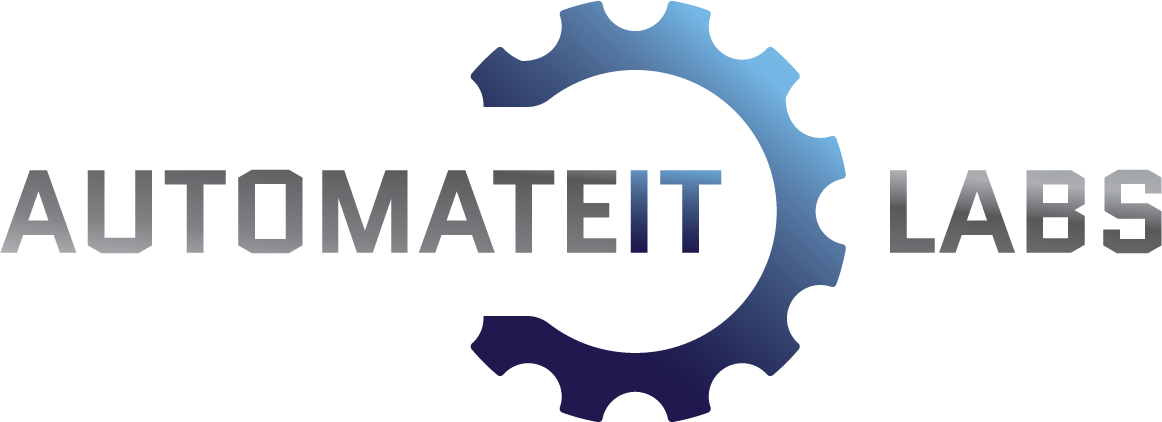Introduction
Every sales team dreams of a pipeline overflowing with opportunities. Rows of names in the CRM. Dozens of calls booked. Deals in every stage.
But here’s the reality: most of that pipeline won’t close.
Across industries, studies consistently show that less than 5% of leads actually turn into revenue. The rest just stall, they vanish, or they were never qualified in the first place.
That statistic may sound discouraging, but it’s also liberating. Because if only a small percentage of your pipeline closes, then the key to winning is learning to prioritize. The pros don’t waste time chasing every deal. They identify the high-probability opportunities early, focus energy there, and let the rest fall away.
This blog breaks down how to prioritize your pipeline like a pro. We’ll look at the numbers behind conversion rates, the common mistakes that flood CRMs with noise, and the systems elite sales organizations use to keep their teams focused on the 5% that really matters.
Key Takeaways
- Less than 5% of most sales pipelines actually closes, which makes prioritization critical.
- Overstuffed, underqualified pipelines drain time and morale.
- Pro sales teams use clear criteria to qualify deals early: budget, authority, need, timing (BANT).
- Technology and automation help sort signals from noise, surfacing the highest-probability opportunities.
- Focusing on the right 5% increases close rates, shortens sales cycles, and boosts ROI on every sales hour.
Why Most Pipelines Are Broken
Ask most sales leaders how big their pipeline is, and they’ll beam with pride. “We’ve got 300 opportunities open right now.”
But dig deeper, and the truth emerges:
- Half are unresponsive after the first call.
- A third were never properly qualified.
- Many are duplicates or long shots that will never move.
The illusion of a “big pipeline” often hides an underlying weakness: a lack of focus.
A bloated pipeline has real costs:
- Time wasted: Reps spend hours chasing dead ends instead of hot prospects.
- Poor forecasting: Leadership can’t predict revenue accurately when most opportunities are fluff.
- Burnout: Salespeople lose motivation when effort doesn’t translate into results.
In short: a big pipeline isn’t always a healthy pipeline.
The 5% Rule
Industry data reveals that:
- Only 25% of leads are legitimate and should advance to sales.
- Of those, only 5–10% actually close.
That means if you start with 1,000 leads, only 50 may ever become real customers.
Instead of pretending the other 950 are worth equal attention, the smartest teams embrace the 5% rule: focus relentlessly on the small set of opportunities with the highest likelihood of closing.
The same way investors don’t put money into every stock, sales leaders shouldn’t put equal energy into every lead.
Separating Signal from Noise
So how do you identify the 5% that closes? It starts with qualification.
Step 1: Define Clear Criteria
Use frameworks like BANT (Budget, Authority, Need, Timing) or CHAMP (Challenges, Authority, Money, Prioritization) to filter leads quickly.
Ask early:
- Do they have the budget?
- Are you speaking to a decision-maker?
- Is there a real problem your solution addresses?
- Do they need it now, or “someday”?
Step 2: Look at Behavior, Not Just Words
A prospect who opens every email, attends webinars, and engages with case studies is signaling real interest. Someone who “loves the idea” but dodges scheduling a call is noise.
Step 3: Track Fit with ICP
Does the lead align with your Ideal Customer Profile (ICP)? If not, they’re likely to churn even if they close. Prioritize those who fit your perfect customer mold.
When you apply these filters consistently your pipeline shrinks, but your close rate climbs.
Why Sales Teams Struggle to Prioritize
If the logic is so clear, why do so many teams still chase the wrong deals?
- Fear of Missing Out (FOMO)
Reps are reluctant to let go of opportunities, even when the signals are weak. “Maybe if I just follow up one more time…” - Pressure from Leadership
Executives often want to see “big pipeline numbers,” creating an incentive to pad CRMs with unqualified leads. - Lack of Training
Many reps are never properly trained in qualification frameworks. They don’t know how to say no to a bad lead. - No System for Prioritization
Without clear criteria or automation, every deal looks the same. So reps default to chasing whatever’s in front of them.
The Science of Pipeline Prioritization
Elite sales teams treat pipeline management like portfolio management. They don’t just fill it, they optimize it.
Here’s how they do it:
1. Weighted Scoring Models
Each lead gets a score based on fit, engagement, and readiness. For example:
- ICP match: +20
- Engaged with content: +15
- Decision-maker: +30
- Timeline within 6 months: +25
Reps then focus first on deals with the highest scores.
2. Pipeline Stages with Strict Exit Criteria
Opportunities can’t advance from one stage to the next without meeting specific requirements. This prevents “wishful thinking” opportunities from clogging later stages.
3. Automation for Lead Sorting
Tools track email opens, meeting attendance, and behavior automatically. Instead of relying on gut feel, data highlights who’s hot and who’s not.
4. Regular Pipeline Cleansing
Every quarter, top teams prune their pipelines, closing out dead opportunities and refocusing on what’s active.
The Art of Pipeline Prioritization
Of course, sales isn’t just math. The human element matters too.
- Gut Instinct: A seasoned rep may sense sincerity in a prospect’s tone or skepticism in their silence.
- Relationship Context: Maybe the deal isn’t hot today, but the contact could be valuable down the road.
- Strategic Exceptions: Sometimes a “low-probability” lead is worth nurturing because of its strategic importance (e.g., breaking into a new market).
The art lies in balancing intuition with discipline. Pros know when to break the rules, but they also know not to do it often.
Case Study: Prioritizing for Results
One AutomateItLabs client, a startup raising capital, came to us with a bloated pipeline. Over 400 “opportunities” sat in their CRM, but deals rarely closed.
We applied prioritization frameworks and automation:
- Defined a clear ICP (investors with funds actively deploying in their sector).
- Scored all opportunities based on engagement and fit.
- Eliminated 70% of low-value leads.
Within three months, their close rate jumped from 2% to 7%. The pipeline was smaller, but healthier. And revenue grew faster because reps weren’t drowning in noise.
The Cost of Not Prioritizing
When companies fail to prioritize, the damage compounds:
- Wasted Salaries: Reps chase dead leads instead of high-probability deals.
- Longer Sales Cycles: Energy spreads thin, slowing down real opportunities.
- False Confidence: Leadership forecasts revenue that never materializes.
- Opportunity Cost: The best leads slip through the cracks while teams are busy with low-value prospects.
Pipeline prioritization isn’t optional, it’s the difference between consistent growth and constant struggle.
How to Start Prioritizing Like a Pro
If your pipeline feels bloated or inconsistent, here’s how to reset:
- Audit Your Pipeline
Be ruthless, eliminate opportunities that don’t meet qualification criteria. - Define Your ICP
Revisit who your best-fit customers actually are (size, role, pain points, timing). - Implement Scoring
Assign objective scores to leads. Focus 80% of energy on the top 20%. - Automate Outreach
Use automation to keep low-priority leads warm while reps focus on high-value conversations. - Coach Reps on Discipline
Train your team to let go of weak deals early. Teach them that “no” is better than “maybe.”
The Future of Pipeline Management
Looking ahead, AI and automation will play an even bigger role in prioritization. Systems will predict close probability with uncanny accuracy, surfacing the hottest leads before reps even log in.
But even as the tech evolves, the principle remains: focus on the few that matter. A disciplined sales culture that respects the 5% rule will always outperform a scattered one.
Conclusion: Less Is More
Good sales teams recognize that only a fraction of your pipeline will close, and build your systems, habits, and focus around that reality.
The 5% rule may sound harsh, but it’s freeing. By letting go of the noise, you give your team the clarity to win faster with less wasted energy.
At AutomateItLabs, this is exactly what we help our clients achieve. We bring automation, discipline, and focus to pipeline generation, so your team spends less time chasing and more time closing.
Because in the end, it’s not about how many names are in your CRM. It’s about the 5% that actually closes.



.svg)


